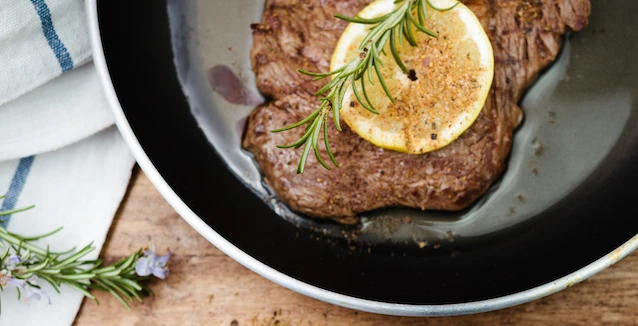
Cooking Basics
How to cook steak
When done right, steak can be one of the most delicious dishes ever. But achieving a crispy sear and a juicy interior can be challenging, even for experienced cooks. But don’t worry – we’ve got you covered!
Keep reading to find out everything you need to know about choosing the right cut of steak, tips for preparation, the different cooking methods for steak, and the best spice blends for steak.
Choosing the right cut of steak
Before you start cooking, it’s important to choose the right cut of meat. Each cut has its own unique characteristics in terms of tenderness, flavour and cooking methods. It’s all about exploring and finding what suits your palate and cooking style. Remember, whichever cut you choose, always buy fresh, high-quality meat for the best results.
Here are some of the most popular choices:
Rib-eye:
Known for its rich marbling and tender meat, this cut is full of flavour and best for searing over a high heat.
Sirloin:
A beefy cut with good marbling, the sirloin is very flavourful and often less expensive.
Filet mignon:
This premium cut is the leanest one with little marbling, ideal for a quick sear to preserve its tenderness.
T-bone:
A two-in-one treat of sirloin and fillet with a bone down the middle separating two different meat textures and flavours.
Rump:
This cut comes from a well-used muscle, making it less tender and very lean, ideal for marinating.
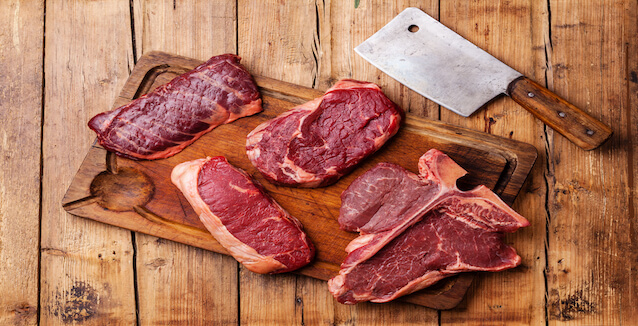

Tips for prepping your steak
Before you even consider throwing that steak on the BBQ or pan, cooking a steak to perfection begins with the prep work. Getting your steak right can make the difference between an average meal and a steakhouse-worthy dish!
Temperature: Remove your steak from the fridge and allow it to come to room temperature for 30 minutes to an hour. This step ensures even cooking.
Pat your steak dry: Remove any moisture, as this can cause the steak to steam rather than sear.
Seasoning: Season your steak generously with salt and your favourite spice blends. Marinate your steak for at least 2 hours, but not more than 24 to avoid overpowering the steak’s flavour.
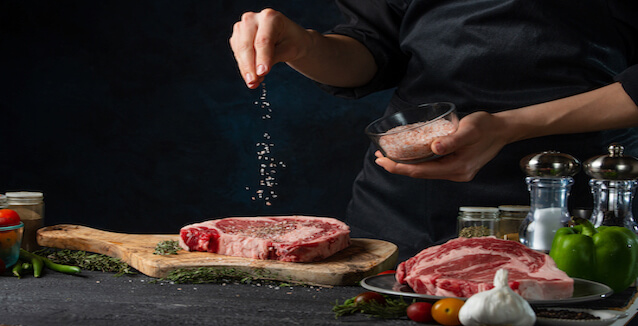

Different cooking methods for steak
The definition of a perfectly cooked steak can vary widely among steak lovers. While some swear by the smoky flavour of a barbecued steak, others may prefer the sear of a cast-iron skillet. Let’s explore the different ways of cooking steak and what each brings to the table.
Cooking your steak on the BBQ
Using the BBQ is a popular method for cooking steak, giving it a smoky flavour and charred exterior. It can also result in a leaner steak since the fat drips away while grilling. But controlling the heat can be tricky, especially over charcoal, so watch the temperature carefully.
Once your barbecue is really hot:
Place the steak on the grill:
Lie the steak perpendicular to the grill grates for those coveted grill marks. Listen for that satisfying sizzle as it sears – a sign that your barbecue is hot enough.
Flip once:
For even cooking and crispy browning, flip the steak only once. Depending on the thickness and desired doneness, this should be between 3 and 7 minutes per side for most steaks.
Check for doneness:
Insert a meat thermometer into the thickest part of the steak. Remember that the steak will continue to cook a little after you remove it from the grill, so it’s wise to remove it a few degrees before it reaches your target temperature.
Pan-searing your steak
Pan-searing your steak gives you a crispy crust and a juicy interior. A heavy-duty, oven-safe pan is best.
Add the oil to the frying pan:
Pour in enough oil to lightly coat the bottom of the pan.
Place the steak in the pan:
You should hear a good sizzle as the meat hits the pan, indicating it’s hot enough.
Sear the steak:
Allow the steak to cook for a few minutes, without moving it, to develop a nice crust. Resist the temptation to constantly check or move the steak.
Turn and continue to cook:
When the first side is browned and releases easily from the pan, flip the steak and sear the other side.
Check for doneness:
Use a meat thermometer to check the internal temperature. As with barbecuing, it’s wise to remove the steak a few degrees shy of your target temperature.
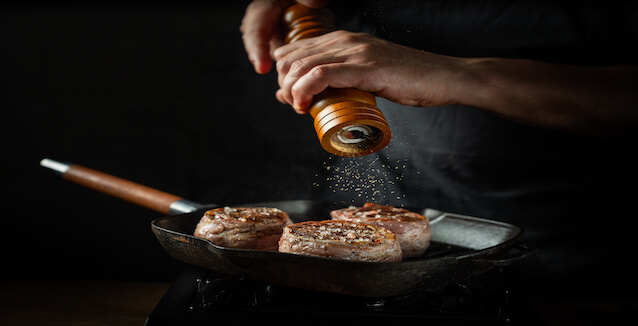

Cooking your steak sous vide
This method, meaning “under vacuum” in French, involves vacuum-sealing your seasoned steak in a plastic bag and then submerging it in a water bath to cook at a precise temperature. By controlling the temperature of the water, you avoid overcooking your steak or any unevenness.
Set the temperature:
Depending on your preferred doneness, set the machine to the desired temperature. For example, 54°C will produce a medium-rare steak.
Seal the steak:
Season the steak with salt all over and add any herbs or spices. Place in the plastic bag and seal, ensuring there is as little air left in as possible so it doesn’t float.
Submerge the steak:
Once the water has reached the set temperature, place the sealed steak into the water bath. Make sure it’s completely submerged.
Let it cook:
Sous vide cooking isn’t about being fast, it’s about precision. A steak can take 1–4 hours, depending on its size and desired doneness, but the beauty is that the window for perfection is wide. Even if you leave it a little longer, your steak won’t overcook. Leave in the bag for 15 minutes to rest after cooking.
Finish with a sear:
After the sous vide process, your steak will be cooked to perfection but will lack the flavourful crust. Quickly sear the steak in a hot pan or on the BBQ for about a minute on each side.
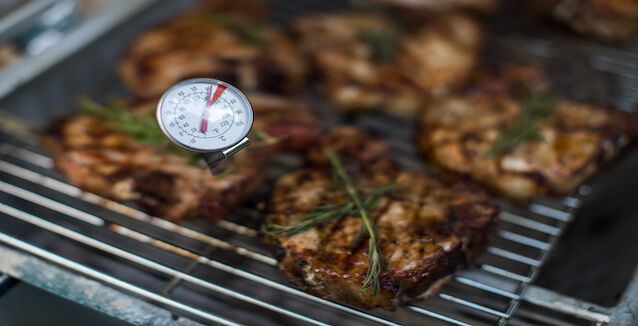

The perfect temperature for your steak
Getting your steak to the perfect temperature is often a challenge. A meat thermometer can be your secret weapon.
Insert the thermometer into the thickest part of the steak, avoiding the bone. Wait for it to read the temperature – it only takes a few seconds. The steak will continue to cook after you remove it from the heat, so aim for a few degrees undercooked.
Rare: 49°C to 51°C
Rare steaks are soft, cool in the centre, and have a deep red hue. They are juicy with a pronounced beefy flavour.
Medium rare: 54°C to 57°C
Arguably the most popular choice among steak aficionados, medium rare offers a perfect balance of tenderness and juiciness. The steak has a warm, vibrant-red centre.
Medium: 60°C to 63°C
Medium steaks showcase a pink centre with more structure, providing a slightly firmer bite while retaining moisture.
Medium well: 65°C to 68°C
The steak at this stage has just a hint of pink left in the centre, and it’s somewhat firmer in texture.
Well done: 71°C and up
Steaks at this level are fully cooked through with no signs of pink. They offer a more robust texture, and care should be taken to prevent them from becoming overly dry.
Best spice blends for steak
Resting and serving your steak
Why should you rest your steak before serving? The answer is pretty simple: As the steak cooks, its juices rise to the surface. Resting your steak for about 10 minutes allows these juices to settle back evenly into the steak, ensuring every bite is juicy and flavourful. The resting phase also allows the steak to finish cooking from the residual heat and come up to temperature.
When it comes to serving, pair your steak with sides that complement its flavour. A classic combo is sauté potatoes and steamed asparagus, but feel free to get creative. Try our steak with tomato chutney, a tangy chimichurri sauce or a rich, buttery Béarnaise. Alternatively, a simple salad with a sharp vinaigrette can provide a refreshing contrast.
Cooking basics with Just Spices
Now you know how to cook steak, whether on a BBQ or in a pan, why not check out our meat recipe collection for more inspiration. You’ll soon learn how to cook beef, chicken and burgers in no time!
For more tips and tricks in the kitchen, check out our cooking basics blog category. You can find all sorts of articles on cooking different ingredients, such as how to cook pasta or how to cook schnitzel.



